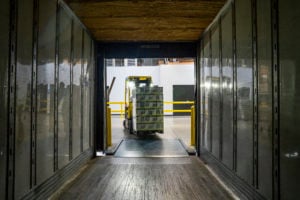Cross-Docking: A Great Choice for Handling Specialty Items

Effective inventory management is always a delicate dance between the cost associated with carrying too much inventory and the risk of not carrying enough to fulfill a customer order at the right moment. With ongoing pressure to ship orders within compressed timeframes, there’s no room for error, and competitors are always on your heels. It’s critical to unearth new ways to generate savings and efficiency at every turn. Cross-docking often leads the opportunity list with its ability to minimize material handling costs and get inbound products prepped for shipment at lightning speed.
Although the practice of cross-docking has been around for quite a while, many organizations shy away from implementing it because they think it’s more work than it actually is. In doing this, they forfeit cost and efficiency benefits that can help them better meet customer demands, particularly for specialty items.
What is Cross-Docking?: A Definition
Just to level-set, let’s establish what cross-docking means. In the purest sense, it occurs when inbound goods are received, sorted, and put directly onto another truck — a true flow-through approach. There’s minimal material handling and ideally no storage. However, in most warehouses, received goods ready for cross-docking have to go into temporary storage locations close to the dock unless the outbound carrier is there at precisely the right time.
Benefits of Cross-Docking
Your ultimate goal is to keep products moving, reducing the number of touches or “fingerprints” throughout the process and avoiding long-term storage. Key benefits include:
- Enhanced ability to fulfill orders quickly and provide stellar customer service
- Reduced chance of product damage because minimal handling is needed
- Less time associated with put-away, picking, packing, and shipping, resulting in lower labor costs
- Reduced need to tie up long-term storage locations, making valuable facility storage space available for other items
- Minimized risk of a specialty item being misplaced or lost in a random storage location, making it appear in inventory but unavailable to fulfill an order
Finding Prime Candidates for Cross-Docking
If you evaluate the types of inventory and orders your warehouse management system processes every day, there will be items that don’t move quickly or have a high level of seasonality. The fact is, these specialty items are costing you more money than they should. To get started with cross-docking, review your inventory and order reports to spot products that are ordered sporadically but must be kept on hand. Seasonal items maintained outside of their fast-moving months are also ideal for cross-docking as you don’t want to devote storage space to them — think lawn chairs, parts for snow blowers, etc. In healthcare, IDNs frequently leverage cross-docking because each department typically wants different items, and some of them fall outside their normal order profiles. These may include a specific type of instrument or med-surg tool needed for a procedure.
What Should Cross-Docking Functionality Look Like or Do for You?
- Allow the cross-dock order for a customer to be received and instantaneously ready to be shipped as it came in. This should be possible without having to involve any handling other than receiving the boxes for the customer order, adding the shipping label, inserting the packing list, and depositing them on the shipping dock for shipment.
- Allow the planning of certain items for a one-time distribution. This includes the set-up of the cross-dock location on the dock to receive those items into the warehouse and allow allocation of the orders to be picked from the same location without having to go through the process of storing the product in the warehouse and then retrieving it for picking.
- Cross-docking functionality should do exactly what it implies: receive and make the product ready for shipping without having to follow the normal warehousing processes of receiving, storing, picking, packing, and shipping. The product should be received and shipped as it came in without any re-handling.
- Cross-docking works well when the product being processed is tied directly to a customer order, allowing direct shipping of the receipt. That means the purchase order sent to the supplier is linked directly to the customer’s sales order to make cross-docking work efficiently. Otherwise, the receiver must split out the total receipt into customer-specific orders, and this requires additional handling that turns it into a regular receive, store, pick, pack, and ship process.


